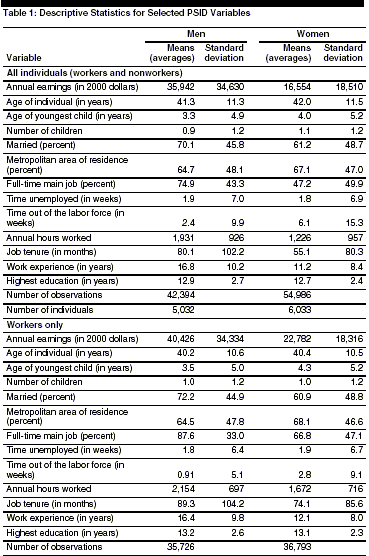GENDER PAY INEQUALITY
Kevin Drum has some interesting commentary on a new study reported in WaPo: GAO Study Finds Work Patterns Don’t Explain Pay Gap Between Men, Women
Women’s income is lower on average than that of men in part because they generally work less, leave the labor force for longer periods and tend to hold jobs that pay less, a congressional study found.
But even after adjustments are made for those factors, women still earned an average of 20.3 percent less than men in 2000, investigators said Thursday.
The 20 percent gap has been relatively unchanged in the past two decades. The difference was 19.6 percent in 1983.
The study could not explain reasons for the earnings difference, but noted that experts have speculated it could be due to discrimination or the decision by some women to forgo career advancement for family-friendly jobs that offer more flexibility and less stress.
Kevin has several explanations, mostly benign at least in intent, based on his own managerial experience that strike me as plausible partial explanations for the phenomenon.
What strikes me as interesting is the research methodology of the study, which I haven’t yet seen. How does one control for working less, taking longer sabbaticals, and taking lower-paying jobs? I suppose one could do regression analysis, but wouldn’t this still be an apples to oranges comparison? If you hold everything constant, so that you’re comparing men and women in the same occupations, same regions, and with identical work histories then you likely have a pretty small “N” for each subcategory. Plus, if there is a huge disparity in career patterns, then there’s no matchup at the aggregate level.
Update (0958): I’ve found the report online.
Update (1017): I’ll delve into more fully later, but a couple of things stuck out with just a quick skim:
In our sample, individuals between the ages of 25 and 65 were tracked from 1983 to 2000.3 Data for some individuals were available for all of these years, while data for other individuals were available for some years only. This is because some individuals entered the sample after 1983. Individuals were not included in the sample until they formed an independent household and reached age 25. We did not use data on
individuals after they reached age 65.
This is perfectly reasonable, given the need to evaluate career patterns. It is problematic, howeer, in trying to figure out the climate today. While 1983 doesn’t sound that long ago to me, it was a differnent eon in terms of gender equality. In the early 1980s, it was still a matter of rancorous debate–much like gay marriage today–as to whether married women should work outside the home if their husbands made enough money to support them. We were being constantly regaled with stories of “the first woman _______ (Supreme Court Justice, astronaut, firefighter, etc.).” A sampling drawn from, say, 1990-2000 would be better.
There are indeed some substantial differences in the pools:

One thing that jumps out at me in the chart is that, in addition to the factors controlled by the study, a much greater percentage of the men are married. That likely means they’re older, more motivated, responsible, etc. on average. That’s not to disparage single people–I am one myself–but just a recognition that the additional responsibility of having one’s career impact others will generally make one more likely to do what’s necessary to get ahead, all else being equal.




How does one control for working less, taking longer sabbaticals, and taking lower-paying jobs?
My question as well. I’d be very curious to see how they accounted for these things, and if they just did some sort of blanket deduction or were more industry-specific. I mean, certain industries are simply going to pose greater challenges to those who work less or take sabbaticals.
If I get energetic, I’ll look up the study and see. I’m not a stats guru by any means, but know enough to at least have a clue about what they’re doing.
Kevin does make some good points… But I think, there is more to it.
You can’t normalize one gender working more than the other.
For example: If I have two employees that are identical in skill but different in gender but one works part time and one works full time, the one that works full time is worth more to my business and will be paid accordingly. I will pay the full timer at a higher rate because of the perceived value to my business. I’m not paying them for their skill, I’m paying them for what they do for my company. (that’s the difference between employees and academics. 😉
I also pay contract labor more because I only use them when things get tight. Many of my contractors have full time jobs. Guys are usually far more willing to work a few hours at night to make a few more bucks. They get paid accordingly.
In my case that second one skews the number dramatically.
I’ve been looking for it over at the GPO site and haven’t found it. Interestingly, the article mentions that the GAO report was conducted for Democratic Reps. Carolyn Maloney of New York and John Dingell of Michigan, but doesn’t mention that either has been quite active in the “fair wage” scenario for some time. A google search turned up a number of articles indicating that they’ve had these reports done in the past, probably in support of various fair wage legislative proposals (the thrust of which would apparently be to find “occupational” discrimination wherever salaries were different for “similar” work).
Oh, one point – looks like while the report may ultimately be available at the GPO site, reports aren’t generally available for a couple of days after the report’s release. Since this one was apparently released yesterday, it probably won’t be available until Monday at the earliest.
So far, all I’ve found:
A 2002 report analyizing women in management which “identified salary differences between men and women in full time management jobs.
The table indicates a very small difference in education (men: 12.9, 2.7sd; women 12.7, 2.4sd) which some would probably take to mean that there aren’t any meaningful differences in education level between the groups, so that that’s not something you need to control for.
Which, I think, is exactly wrong, because the length of your education doesn’t really determine your income. What and where you study is far more important; generally a B.Sc in Computer Science is worth more than a B.A. in Transgendered Eskimo Women’s Studies, and a degree from Harvard is worth more than a degree from a diploma mill.
—